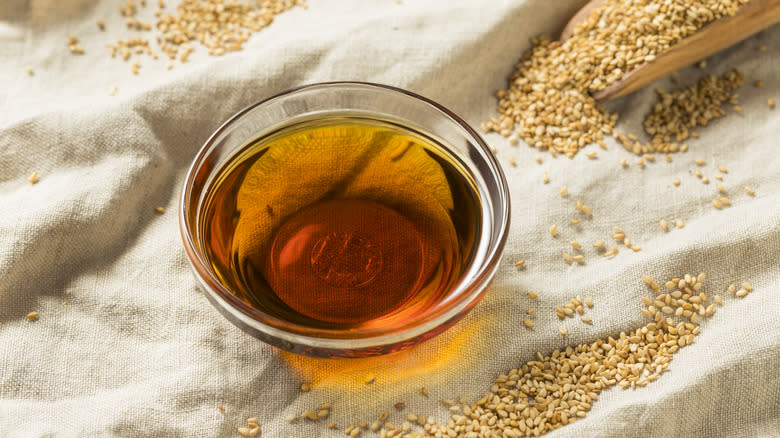The Correct Way To Store Sesame Oil So It Keeps Its Flavor

Rich, nutty, and fragrant sesame oil is a mighty seasoning in the kitchen, essential for both marinades and finishing dishes in Southeast Asian and Levantine cuisines. This makes it a standby ingredient, but it's important to look after it so that all the incredible and complex flavor doesn't turn rancid and bitter sooner than you'd think possible.
While sesame oil isn't so perishable that it absolutely must be in the fridge at all times, it is prone enough to rancidity that keeping it handy by your oven isn't a good idea, even if it is used frequently. Keeping your bottle in the cold and dark of the fridge after opening it is the best way to avoid the nasty, expensive surprise of gone-off oil that can't be salvaged; if you've got unopened bottles ready to go, store them how you might most cooking oils, in a cupboard.
Read more: What These Imitation Foods Are Actually Made Of
Why Sesame Oil Spoils So Easily

Sesame oil comes in two key categories, and the difference between them defines not just their flavor but also why sesame oil needs careful storage. Refined sesame oil is untoasted and has barely any aroma. It has a high-smoke point that is ideal for cooking.
The sesame oil you use for regional Chinese cooking, Japanese dipping sauces, or Korean marinades is toasted and unrefined, contributing to its incredible flavor. These qualities, combined with the fact that sesame oil is mainly composed of unsaturated fat, make it susceptible to going rancid. That process is accelerated by heat, light, and humidity, so leaving it out on the counter is a recipe for disaster. By contrast, refrigeration prolongs its life, and the cloudiness it causes in unrefined sesame oil does not impact the flavor whatsoever.
How To Use Your Sesame Oil

Because of its intense flavor, sesame oil tends to be deployed in small amounts, in balance with other sources of saltiness, sweetness, and acidity. But if you're concerned that a bottle is close to turning from delicious to distressing, there are plenty of ways to use it in quantity (outside of a large batch of marinade.)
The classic Chinese smacked cucumber salad relies heavily on the richness of sesame oil to coat the vegetable and balance the black vinegar, chili oil, and soy sauce, while cold sesame noodles unsurprisingly use a heavy hand with both sesame seeds and their oil. Notably, tahini — also made of sesame seeds, is a staple condiment and is sometimes used in place of sesame oil when a creamy texture is desired — is not as prone to rancidity as sesame oil. Tahini should only be stored in the fridge if a thicker, spreadable texture is needed or desired; sesame oil is safest kept there.
Read the original article on Daily Meal.

